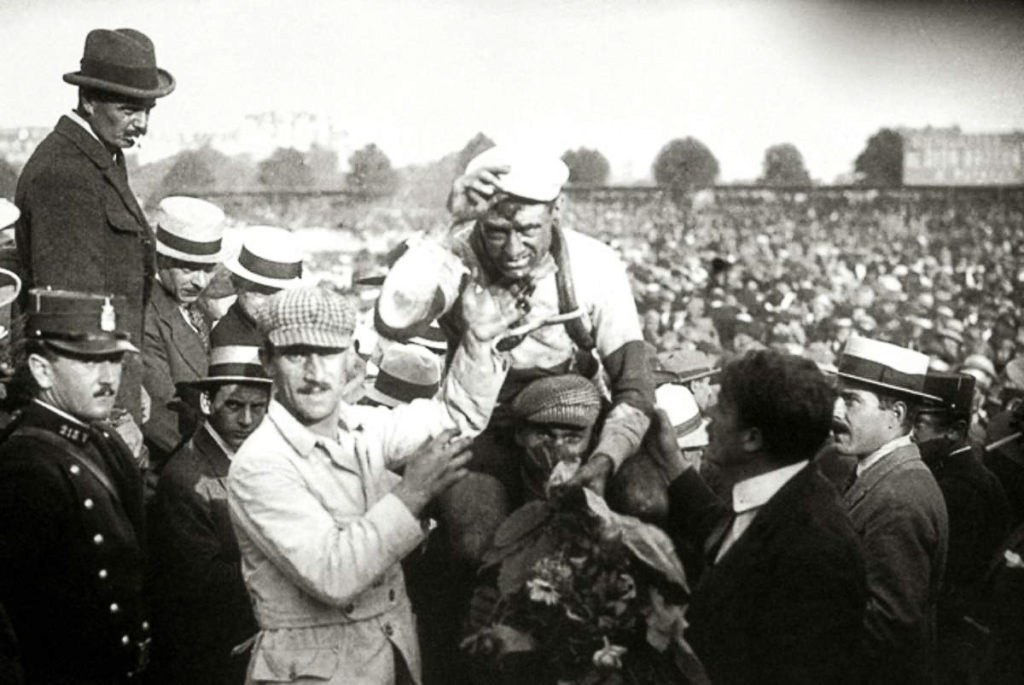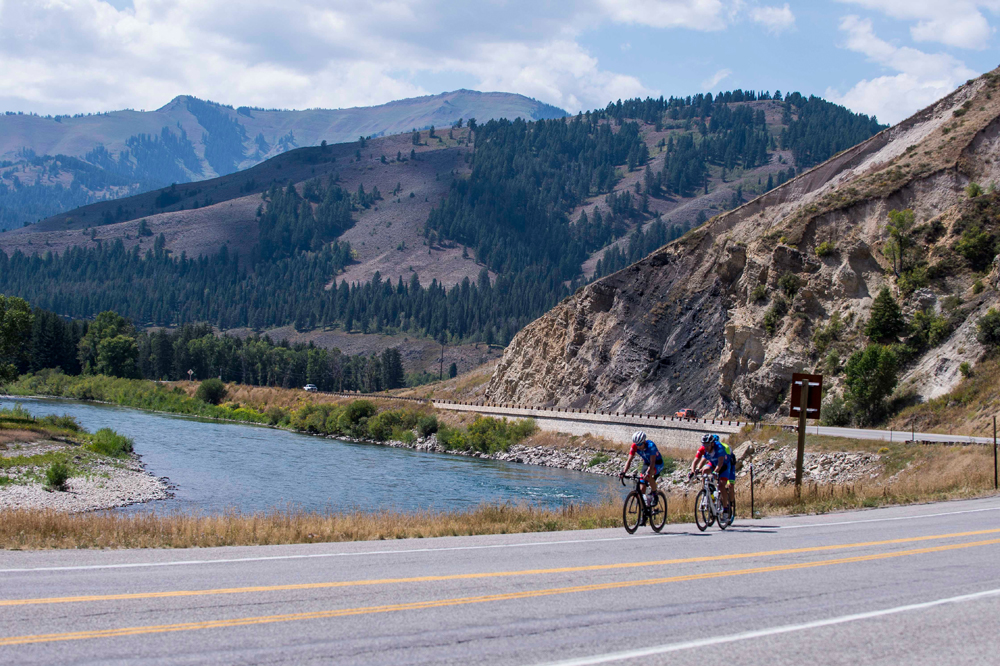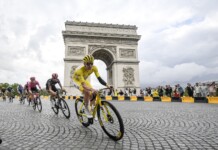2019 marks a number of milestones in the history of the Tour de France. It is the 30th anniversary of Greg LeMond’s 58-second defeat of Laurent Fignon in the final time trial on the Champs-Élysées to win the 1989 Tour by 8 seconds, the slimmest margin in the history of the race.
It is also the 50th anniversary of Eddy Merckx’s first of five Tour de France victories in 1969. In his début appearance, Merckx took the first 6 of his 34 stage wins and wore the maillot jaune as leader of the race for 18 stages in the process. By the time the race finished in Paris 3 weeks later, Merckx had also clinched the Points and King of the Mountains competitions on his way to an overwhelming 17’54” victory over second-place finisher Roger Pingeon, with third-place finisher Raymond Poulider at 22’13”.
Most importantly, 2019 also marks the 100th anniversary of the introduction of the maillot jaune, the yellow jersey, to signify the leader of the race, and that is a story in itself.

The 1919 Tour de France, which had been suspended from 1915 to 1918 due to The Great War, was announced in L’Auto in November 1918, just days after the Armistice bringing a halt to fighting was signed; however the Treaty of Versailles, officially ending the war was not subsequently signed until June 28, 1919, just one day before the start of the Tour.
Many of the pre-war stars of the Tour de France were killed in the fighting. Luxembourger François Faber, the winner of the 1909 Tour, joined the French Foreign Legion and was killed during the Battle of Artois in 1915. Octave Lapize, winner of the 1910 Tour, became a fighter pilot during the war, and was shot down in July 1917, subsequently dying from his injuries in hospital. Lucien Petit-Breton, winner of the 1907 and 1908 editions of the Tour was killed in December 1917 while driving for the French Army. In total, over 60 professional riders, on both sides, were killed during the course of the war.
While the Armistice did bring a cessation to hostilities, since the war did not officially end until the Treaty of Versailles was signed, the French army only demobilized soldiers over the age of 30 over the winter. Younger soldiers were kept in service in case the armistice fell apart and fighting resumed. While this did not happen, by the time the Tour did start on June 29, 1919, there were only 67 entries; 43 professional riders and 24 isolés (unsponsored amateur riders), almost all of whom were over the age of 30.
France was devastated during the war, especially in the North where much of the fighting had been concentrated. The 1919 Tour avoided the worst of the battle-scarred regions, unlike the ill-fated Circuit des Champs de Bataille (Tour of the Battlefields) whose solitary edition happened just a few months earlier in April 1919. However, by the summer of 1919 road conditions were still not ideal for a bicycle race. When the race reached Paris on July 27, only 11 riders remained, 10 of whom were professionals. Of these, Frenchman Paul Duboc was later disqualified for accepting a ride in a car early in the race.
Many stars of the peloton who had survived the war were not able to survive the brutal conditions of the race, abandoning along the way. Riders dropping out included the French Pélissier brothers, Henri and Francis; the Belgian Buysse brothers, Lucien and Marcel; and the Belgian winner of the 1913 and 1914 editions of the Tour, Philippe Thys. All of the amateur riders, save one, also dropped out of the event along the way.
Jules Nempon, the last remaining isolé, thus earned the honor of a 10th place finish as well as taking the prize for being the lanterne rouge, the last rider in the process. Henri Pélissier would eventually go on to win the Tour de France in 1923, while Lucien Buysse would do the same in 1926.
Amongst the 10 official finishers was the Frenchman Eugène Christophe. Christophe was already well known for his tragicomic experiences in the pre-war Tours de France of 1912 and 1913, but 1919 sealed his place in Tour de France history.
A scandal-ridden race in 1904 had threatened to derail the legitimacy of the Tour de France, so from 1905 through 1912 in an effort to reduce cheating by the riders, the Tour was scored on points instead of time.
In 1912, Christophe won three consecutive stages in the mountains, opening up quite a large time gap to his rivals, most notably the Belgian Odile Defraye. Defraye was primarily known for his sprint, but he was able to limit his time losses in the mountains. Christophe, on the other hand, did not have a strong sprint, and would generally finish further down the order on the flat stages when several riders came in at the same time.
By the end of the 1912 Tour, Christophe had the lowest overall time, but because the Tour was scored on points, the overall victory went to his Belgian rival. This was the last year overall victory in the Tour was decided on points, although the competition was reintroduced in 1953 as a secondary classification.
In the 1913 Tour de France, Christophe’s fork broke while descending the Col du Tourmalet as the leader on the road, after he was hit by a race vehicle. In those early races, riders were responsible for carrying out all repairs on their own, except at a few officially designated checkpoints. Since Christophe was not near one of these checkpoints, he was forced to hike 10km down the mountain to the village of Ste-Marie-de-Campan followed by one of the race commissaires.
He then had to find a blacksmith with a working forge, and repair his own fork, then climb back up the mountain to the site of his mishap to resume his race nearly 4 hours later. Adding insult to injury, he was fined an additional 10 minutes by the commissaire for allowing a village boy to operate the bellows on the forge while he conducted his repairs. Christophe ultimately finished the 1913 Tour in 7th place, a little over 14 hours behind the winner, Philippe Thys.
By Stage 10 of the 1919 Tour, Christophe was once again the general classification leader of the Tour de France. However, spectators and the press had problems distinguishing one rider from another on the road, as most were wearing the grey woolen jerseys of La Sportive, a conglomeration of bicycle manufacturers whose businesses survived the war. Until this point, the leader of the race was designated by wearing a small green armband, which could easily be missed in a fast-moving peloton, especially in wet and muddy conditions.
Members of the press suggested to Henri Desgrange, L’Auto’s publisher and organizer of the Tour, that the general classification leader be given a special jersey to wear so that he could be easily picked out of a group of riders. Desgrange approved of the idea, and a yellow jersey was found and given to Christophe to wear starting with Stage 11 on July 19; whether the color of the jersey was inspired by the yellow paper on which L’Auto was printed, or was simply the only color available due to postwar shortages is up for debate.
Eugène Christophe, for his part, was initially none too pleased about being asked to wear the yellow jersey, claiming that he was mocked by the other riders for looking like a canary.
Unfortunately for Christophe, he would not be able to wear the yellow jersey into Paris. On the penultimate Stage 14, on July 25 on cobbled roads near Valenciennes, he once again broke his fork. This time, he only had to travel one kilometer to find a bike shop with a forge, but as in 1913 he had to conduct his own repairs, losing about 2.5 hours in the process to stage and eventual overall winner Firmin Lambot. Christophe ultimately finished the 1919 Tour de France in third place.
Christophe’s story captured the imaginations of L’Auto’s readership, and Henri Desgrange launched a subscription to raise money to award him for his perseverance; ultimately Christophe’s prize of 13,310 francs was nearly triple the 5,000 francs awarded to Firmin Lambot for winning the overall race.
Sadly, Christophe’s bad luck would continue, and in 1922, once again he was forced to hike out of the mountains, this time off the Col du Galibier, with a broken fork. In 11 total participations in the Tour, Eugène Christophe would finish a total of 8 times including his final attempt in 1925 at the age of 40, spending a total of 13 days in yellow in 1919 and 1922. He would finish twice on the final podium, in 1912 and 1919, but never as the overall winner.

He finished 18th. Photo by Agence Rol, Source gallica.bnf.fr – National Library of France.
Nonetheless, the rider who was mocked for looking like a canary had the honor of wearing the first official maillot jaune in the history of the Tour de France, which is still one of the sport’s most coveted prizes 100 years later.
1919 Tour de France Final General Classification
| Rank | Rider | Category | Time |
| 1 | Firmin Lambot (BEL) | A | 231h 07′ 15″ |
| 2 | Jean Alavoine (FRA) | A | + 1h 42′ 54″ |
| 3 | Eugène Christophe (FRA) | A | + 2h 26′ 31″ |
| 4 | Léon Scieur (BEL) | A | + 2h 52′ 15″ |
| 5 | Honoré Barthélemy (FRA) | A | + 4h 14′ 22″ |
| 6 | Jacques Coomans (BEL) | A | + 15h 21′ 34″ |
| 7 | Luigi Lucotti (ITA) | A | + 16h 01′ 12″ |
| 8 | Joseph Van Daele (BEL) | A | + 18h 23′ 02″ |
| 9 | Alfred Steux (BEL) | A | + 20h 29′ 01″ |
| 10 | Jules Nempon (FRA) | B | + 21h 44′ 12″ |
For more on the 1919 Tour, We Rode All Day: The Story of the 1919 Tour de France, by Gareth Cartman is a great book. Imagined and told from the perspectives of the riders and organizers, this is not a typical historical recap of the race, but attempts to take the reader into the minds of those who made the event special. 236 pages.
Another great read on the impact the Great War had on pro cycling, is The Shattered Peloton: The Devastating Impact of World War I on the Tour de France, by Graham Healy. 240 pages.
Celebrating the Maillot Jaune at the 2019 Tour de France
The 2019 Tour de France starts on Saturday, July 6, 2019 in Brussels, Belgium to commemorate the 50th anniversary of Eddy Merckx’s first participation and victory. The anniversary of the maillot jaune will be celebrated during the Stage 13 time trial in Pau on July 19, 100 years to the day after the first maillot jaune was awarded to Eugène Christophe.
Throughout this year’s race, an individual jersey design will be awarded to the general classification leader featuring an appropriate image for that day’s stage. The jersey issued after Stage 1 (to be worn on Stage 2) will feature the Atomium, to commemorate the race start in Brussels. Stage 2’s jersey will highlight Eddy Merckx, in honor of the 50th anniversary of his 1969 vicotry. The jersey to be worn during the Stage 13 time trial memorializes Eugène Christophe, the first wearer of the maillot jaune in 1919. The final jersey issued after Stage 20 will feature Paris’s iconic Arc de Triomphe on the Champs-Élysées, which has hosted the grand finale of the Tour de France every year since 1975.












